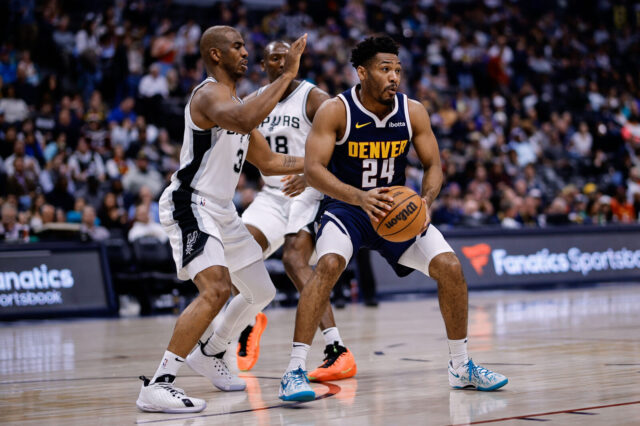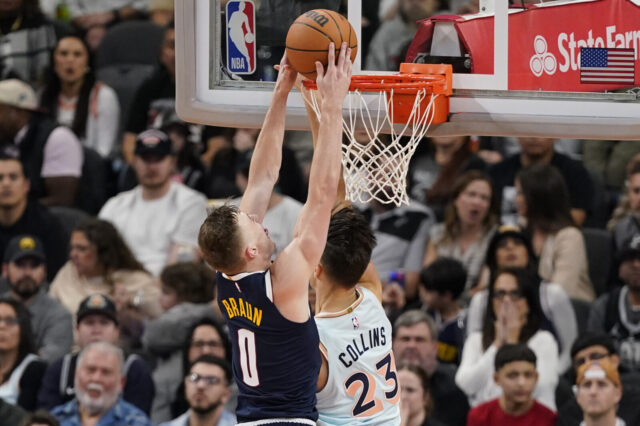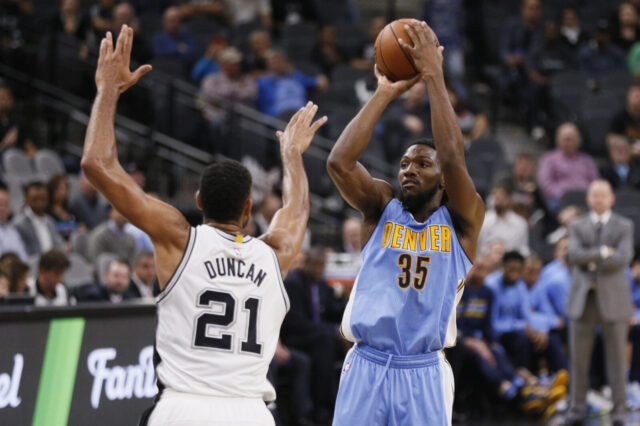When Michael Malone said in a press conference in early November that Michael Porter Jr. would be “out for the foreseeable future,” I mentally prepared myself for the worst.
The wording was ambiguous, and it was spoken that way for a reason. We now know that the initial prognosis of Porter’s back injury done after the Denver Nuggets win over the Houston Rockets on November 6th was pretty dire. The Nuggets let Porter take his time, assess his options, and see if there were any alternatives to be had rather than a third surgery to fix his back. It’s clear that whatever options Porter and the Nuggets identified weren’t better than getting the problem fixed, likely because the chance of re-injury or permanent damage was much higher.
That part is speculation. The next sentence is fact. This really, really sucks for everyone involved, especially Porter.
The reporting from Adrian Wojnarowski surrounding Porter’s injury is that he will have surgery at some point in the near future. Depending on the recovery window, it’s possible that he could be back sometime this season; however, it’s better in this instance to assume he won’t return. The Nuggets need to find a tangible solution, something reliable for a playoff push this season. Because even if Porter isn’t able to play, the Nuggets still have a roster capable of making a deep run IF Jamal Murray returns to full strength. Understandably, that’s a big if, but it’s better than wasting a year of Nikola Jokić looking like the best player in the NBA.
So, what does Porter bring to the table that the Nuggets may or may not be missing right now? Here’s a list of Porter’s best traits:
- Outside shooting
- Perimeter size
- Athleticism
- Rebounding
- Shotmaking talent
To borrow a line from Moneyball, the Nuggets may not be able to replace Michael Porter Jr. (and P.J. Dozier, also a large absence), but they might be able to recreate him. Let’s look at each of those traits and gauge how seriously Denver needs to replace those individual skills:
Three-point shooting
The Nuggets rank 19th in the NBA in three-point percentage at 33.5%. They’re trending in a positive direction after ranking 28th more much of the season. Last season, they ranked seventh, shooting 37.7% from distance. Every team (I believe) has seen a drop off in three-point shooting for some reason or another, but the Nuggets are one of the teams that has dropped off the most.
Part of the reason is Porter, because they haven’t had him for half of the games, and even when they did have him, he was shooting just under 21%. That was always expected to turn around though, just like Denver’s overall shooting numbers.
It’s too early to tell whether the Nuggets NEED more help in the outside shooting department to win games, but the only NBA championship team to rank outside the top 10 in three-point percentage in the last decade was the 2019-20 Los Angeles Lakers in the bubble, and they had fully rested versions of LeBron James and Anthony Davis after the off period from March to July. It’s safe to say the Nuggets could use more shooting. That’s the old adage anyway.
Championship factor: High
This content is no longer available.
Perimeter size
Porter isn’t only an elite outside shooter. At 6’10” he towers over smaller players, giving him advantages (and disadvantages) against other wing and forward options around the NBA. Being tall isn’t in it of itself a skill, but Porter learned how to use that size and height on his jumper (one of the highest releases in the league) and on cuts to the rim. He paired well with Nikola Jokić in high-low actions, leveraging his shooting ability for easy baskets inside.
The Nuggets are in a much better position to combat Porter’s absence from a size perspective than they were the year before. Aaron Gordon gives the Nuggets an extra dimension of size on the defensive end, and his ability to switch up and down the lineup as an on-ball defender gives Denver plenty of flexibility. His offensive game has also taken a step forward with good shooting efficiency around the basket and behind the three-point line, which he can take advantage of shooting over smaller players. Jeff Green has also reprised much of Porter’s role as a shooter and cutter, and at 6’8” himself, Green has shown the ability to switch and play solid positional basketball on both ends of the floor at many of his previous stops.
The Nuggets could definitely use another wing or forward with size off the bench though. Green was supposed to provide that versatility for the bench unit. Now, he’s doing it for the starters, and the bench has one less option to tie lineups together. In addition, P.J. Dozier played a full 85% of his minutes at small forward and power forward this season, highlighting the need to find a player who can replace him as well. Another player on the roster in the 6’6” to 6’10” range would go a long way, especially if that player can shoot and defend.
Championship factor: Medium
Athleticism
One of the best highlights of Porter’s career to date was his poster dunk over Montrezl Harrell in the bubble. Driving off an erratic closeout by his defender and jumping over the big, yamming all over an unsuspecting Harrell in the process. It was awesome.
When Denver acquired Gordon, they suddenly became one of the more athletic teams in the NBA, putting Porter with Gordon and Will Barton in the starting lineup to form a versatile, high flying trio. With Jeff Green out there in Porter’s place, the athleticism, somewhat surprisingly, remains on even ground. Green’s ability to get out in transition, go up for big dunks, and contest shots above the rim has really stood out since he entered the starting lineup. That group hasn’t really missed a beat.
The bench, much like in the size department, is also missing some athleticism. Facu Campazzo, Bones Hyland, and JaMychal Green have been the primary producers, and that trio could certainly use another athlete. Still, this is a lower priority than the positional size, and it’s one reason why the solution, Zeke Nnaji, might already be on the roster.
Championship factor: Low
This content is no longer available.
Rebounding
On the season, the Nuggets rank 14th in rebounding rate. That’s a far cry from where they were a season ago when they ranked third. They were sixth in defensive rebounding rate and second in offensive rebounding rate last year. This year they’re 19th in offensive rating and fifth in defensive rating, speaking to a sizable weakness without Porter on the floor. This is a category where Gordon and Green don’t help as much either, especially Green. His offensive rebounding rate of 1.9% on Basketball Reference is more in line with a point guard than a 6’8” forward.
The bench is actually better at grabbing offensive rebounds than the starters. Zeke Nnaji leads all (borderline) rotation players with an 11.0% offensive rebounding rate, which is very high. He takes advantage of the dribble penetration created by the guards. When Facu, Bones, and others lure Zeke’s defender over to contest layups, he’s available for putbacks. The same goes for JaMychal Green who’s having a strong rebounding season as well.
Denver’s offensive rebounding may be dampening their offensive firepower a bit, but the counter has been better transition defense. As long as the Nuggets continue to make that tradeoff successfully, I’m not concerned with the offensive rebounding. Jokić and others will rack up the offensive rebounds when need be.
Championship factor: Low
Shotmaking talent
Whether it’s from two-point or three-point range, the teams that make shots at the most efficient clip are often the ones that advance the furthest in the playoffs. There’s only so far that athleticism generally goes (unless you’re Giannis Antetokounmpo) but executing sets well by creating and making open (or contested) shots is generally the way to go far.
Michael Porter Jr. is one of the best at making contested looks. It didn’t translate to the playoffs, but it did when things mattered most in Games 5 and 6 of the first round against the Portland Trail Blazers. Porter’s shot making, his clutch shot making, helped propel the Nuggets further than they should have gone.
Sometimes, a team just needs a great player to create a good shot. The Nuggets lost that a bit when Murray went down, and they hope to get it back when he returns. Murray’s ability to shoot off the dribble and make tough shots look easy is at the upper echelon of NBA stars. He is the key to replacing Porter’s tough shot making ability and perhaps improving upon it. The part missing from the Jokić and Porter shotmaking time is how it sometimes appeared to be a chore for them while they figured out their chemistry in key moments. Jokić and Murray have already gone through that, and they’ve reached the pinnacle together.
Championship factor: High, but Low if Jamal Murray returns near to full strength
The best thing the Nuggets can do for their championship hopes at this point is focus on Porter’s best traits (three-point shooting and perimeter size) and add someone to the bench that can fill in reasonably well. It will be impossible to fully replace Porter, but the Nuggets are certainly capable of adding a 3&D wing if they’re willing to pay the price. They don’t have a ton of resources, and that will determine their ability to make trades.
Still, it’s worth trying. Whoever they add very well could be in the plans for future seasons as well. This player doesn’t have to be starter caliber either. Filling in the gaps as a smart, high IQ player that can shoot, rebound, and defend a little would do wonders for the bench unit. That way, if the Nuggets do find themselves in a playoff environment, they will be the best version of themselves. Or at least the best version they CAN become this season.


